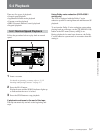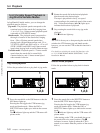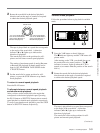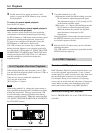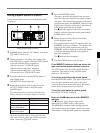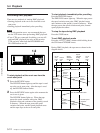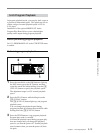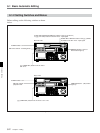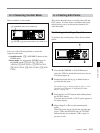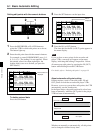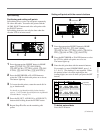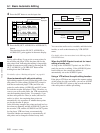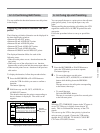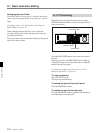
Chapter 6 Editing 6-1
Chapter 6 Editing
Chapter 6 Editing
6-1-1 Overview of Automatic
Editing
Automatic edit modes
The VTR provides the following two modes for
automatic editing:
• Assemble mode
New scenes are added to the end of previously
recorded scenes.
CTL signals, time codes, video and audio signals on
tape in the player are recorded onto tape in the
recorder VTR.
• Insert mode
New scenes are inserted into the middle of previously
recorded scenes. CTL signals on tape in the recorder
VTR are not overwritten. Video, digital audio, cue
audio, and time code signals can be recorded
separately.
Both of these two edit modes support DMC editing.
In insert mode, you can also use split editing.
Interpolation of time codes by the CTL
counter
To use time codes as addresses of edit points, the time
codes must be recorded on the tape in ascending order.
As long as they are in ascending order, time codes do
not have to be continuous.
The CTL counter automatically interpolates data for
editing even if there are breaks in the continuity in the
time codes.
Time codes recorded during automatic editing
During automatic editing, time codes recorded on the
tape always follow immediately after time codes
recorded right before an edit start point, regardless of
the setting of the [F6] (TCG SOURCE) and [F7] (TCG
MODE) buttons of TC menu.
For details on the switch settings necessary for changing the
time codes recorded, refer to “4-3 TC Menu” on page 4-18
and the 600 menus in the VTR SETUP menu.
6-1 Basic Automatic Editing
Steps in automatic editing
The sequence of steps that are taken to do automatic
editing with two VTRs is as follows:
Select the edit mode (page 6-3).
.
Set edit points for the recorder and player VTR
(page 6-3).
.
Preview the edit section (page 6-8).
.
Perform the edit (page 6-11).
.
Confirm and modify the edit points
(pages 6-7 and 6-9).
.
Confirm the results of the edit (page 6-13).
Editing precautions
Using an editing control unit
When using an editing control unit to control the VTR,
set the edit delay on the control unit so that CUT-IN
and CUT-OUT commands are sent to the VTR five
frames ahead of the actual edit point.
Video signals output to a monitor
While in E-E mode or when playing back in edit mode,
the V-sync phase of the video output is delayed 6H (on
the DVW-A500/1 and 500/1) or 4H (on the DVW-
A500P/1 and 500P/1) with respect to the external
reference signal. You can also adjust the V-sync phase
so that it is in sync with the external reference signal
phase, but without affecting the video signal delay.
Change the V-sync phase through 701. SELECTION
OF VIDEO/SYNC DELAY in the VTR SETUP menu.



